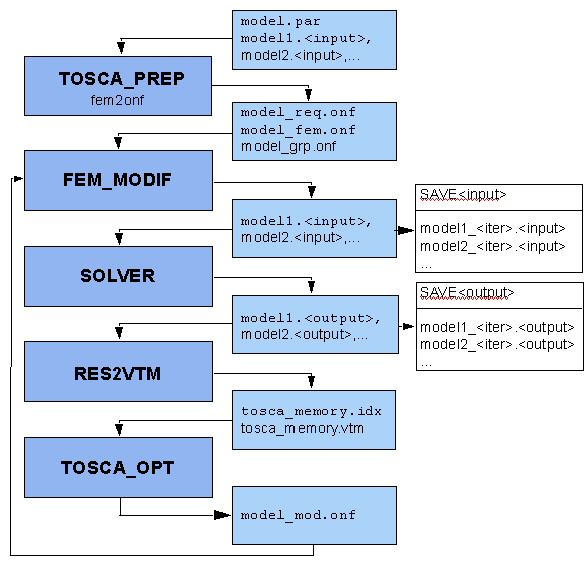Overview | ||
| ||
The flow diagram below is identical for all FE solvers. The optimization
preprocessor TOSCA_PREP executes the program fem2onf.
This program converts the FE-input file into a neutral file format
(ONF). The essential information regarding the FE-model
is written in the neutral file. The first file called <jobname>_req.onf
contains the result requests. These are the FE-results needed for the
optimization module. The second file contains FE-model (<jobname>_fem.onf)
information, that is, grid points, elements and etc. The last file contains
the group definitions (<jobname>_grp.onf).
The optimization iterations begin when the preprocessor is finished.
No previous optimization iterations exist for the first optimization
iteration. However, FEM_MODIF modifies the FE-input
files (model1.<input>, model2.<input>, ...)
which ensures that requested results are present after FE-analysis.
The chosen FE solver calculates the requested results (model1.<output>,
...). The specific results required for the optimization are
read by RES_2_VTM and the results are stored in the database
(tosca_memory). Using these results the optimizer TOSCA_OPT
generates a modification file (<jobname>_mod.onf).
Afterwards, FEM_MODIF once again modifies the original
FE-input file using the modification file. The standard configuration
ensures that the FE-input files will be stored for each optimization
iteration in the directory SAVE.<input>. The directory
SAVE.<input> also contains the original input
file having the name model_org.<input>. The first
and last FE results files are stored in the directory SAVE.<output>.
Flow diagram for SIMULIA Tosca Structure  |
Solver type |
SIMULIA Tosca Structure supported input |
SIMULIA Tosca Structure supported output |
|---|---|---|
Abaqus |
*.inp |
*.fil or *.sim (see below) |
*.odb |
||
ANSYS® |
*.cdb |
*.rst |
*.dat |
||
*.inp |
||
MSC Nastran® |
*.bdf |
*.op2 |
(*.dat) |
Some features in SIMULIA Tosca Structure are not available for all solver interfaces.
Solver |
Sensitivity-based Optimizations with contact |
Use of internal Forces |
Frequency Response Optimizations |
|---|---|---|---|
Abaqus |
X |
X |
X |
ANSYS® |
X |
X |
X |
MSC Nastran® |
X |
X |